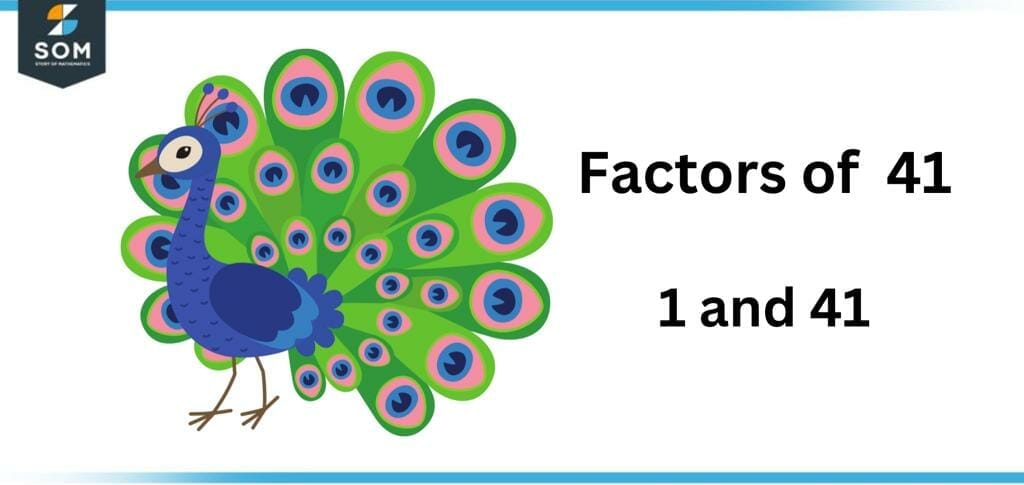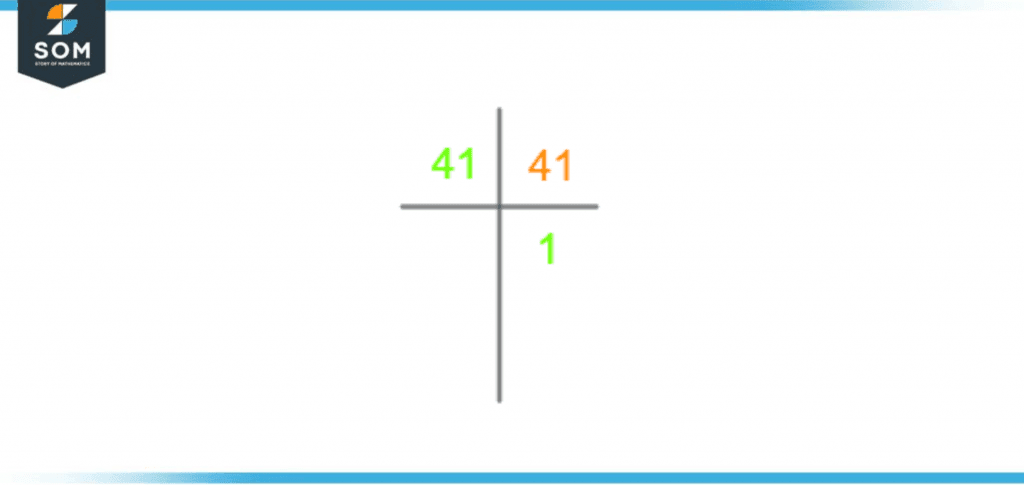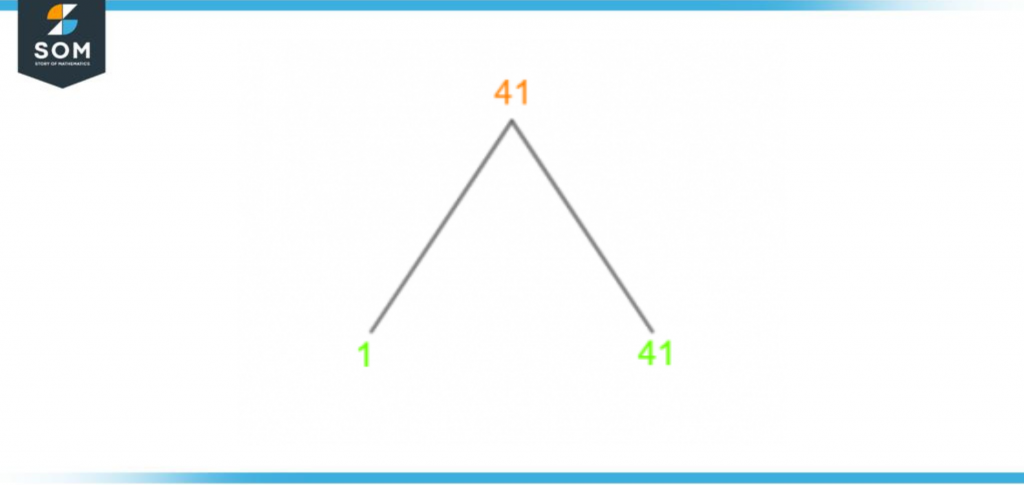JUMP TO TOPIC
Factors of 41: Prime Factorization, Methods, Tree, And Examples
The factors of any number are considered to be the divisors that perform complete division without any remainder. For the number 41, its factors would be all the numbers that divide it perfectly. By perfect division, it is understood that the remainder should always be zero.

Figure 1 – All possible Factors of 41
When the number 41 is divided by its factor, it will always output a zero remainder. When these numbers or factors are multiplied by each other, specifically when their factor pairs are multiplied, the result is the original number. This is a curious fact about all the factors.
In mathematical terms, the natural number 41 is a prime number which indicates that it does not have factors other than one and the number 41 itself. In fact, as it is an odd prime number, it means that it does not have more than two factors.
Multiple procedures and techniques have been determined to calculate the factors of any number, such as 41. These methods are simplistic yet yield accurate results.
One of them is the prime factorization method. Still, for beginners, it is encouraged to start with another method called the division method, which has been hailed as the easiest method of calculating factors.
As the division method is easier to understand, we begin by trying to assimilate our knowledge of this technique. It follows the basic mathematical process of division; upon dividing the number given by any random number, the quotient might be a decimal or a natural number.
But for a divisor to be a factor, the quotient must always be a natural number. As 41 is a prime number, it is only perfectly divisible by 1, so it does not have many complicated factors.
This guide explores the factors of 41 in detail, along with examples for a better understanding of the factorization procedures used for the calculation of factors of 41.
What Are the Factors of 41?
The factors of 41 are 1 and 41 itself as it is a prime number. These are the only numbers that generate zero as the remainder.
This helps us understand the concept of prime numbers as well. As 41 only has two factors which are 1 and 41, it is proved that 41 can be categorized as a prime number.
How To Calculate the Factors of 41?
You can calculate the factors of 41 by using multiple methods: these methods are the division method and the prime factorization method.
41 is a prime number, its factorization is not a complex task, but it is imperative to understand the basics of finding factors. Let’s begin with understanding one of these methods: the division method, which is the easiest way of determining factors.
The division method is a traditional and basic approach to determining the factors of any number. According to this method, numbers that produce a natural quotient and a zero remainder are considered factors of the number. These are the necessary conditions for factor determination.
Both the quotient and divisor are the factors of the number dividend, which in our case is 41. Understanding these conditions in the division method let us proceed to the calculation of the factors of 41:
\[ \frac{41}{ 1} = 41 \]
We know that 41 is only divisible by one, and itself since a whole number quotient is produced, this division indicates that both 41 and 1 are factors of 41.
Let’s find the factors of 41 using the division method:
\[ \frac{41}{ 1} = 41\]
\[ \frac{41}{ 41} = 1\]
A list containing all the factors of 41 is given below:
Through the division method, we have calculated the following factors of 41:
Factors of 41: 1 and 41.
We can see that number 41 has two factors where. One is the number itself, and the other is the digit one that divides all the natural numbers. On the same note, these factors also happen to be the largest and smallest factors, respectively.
Factors of 41 by Prime Factorization
Prime Factorization is a factor-finding technique in which the division is performed with the help of prime numbers. In prime factorization, division operation continues until one is obtained at the end.
Through prime factorization, we find out factors that, once multiplied, give us the original number, which is 41. The product of these prime factors is always the actual number. Dividing the number by prime factors also yields a zero remainder.
The prime factorization of 41 can be represented as:
41 = 1 x 41
Prime Factorization of 41 = 1 x 41
The prime factorization of 41 is also shown below:

Figure 2 – Prime Factorization of 41
Factor Tree of 41
Another method used to find out the prime factors of a number is a visual tool called the factor tree. It basically divides the number into prime numbers represented by the different branches of a tree.
As the name suggests, the factor tree takes the shape of a tree at the top of which sits the original number, dividing into branches upon each division. The division continues until the prime numbers are reached, and no further division is possible.
For the factor tree of 41, the initial branches will extend out from 41 and continue dividing until prime factors are obtained at the end, or further division is impossible. 41 is shown below in figure 3:

Figure 3 – Factor Tree of 41
Factors of 41 in Pairs
Another property of factors is that they can be divided into pairs. These pairs are characterized by their ability to yield back the original number. If a pair gives the actual number upon multiplication with each other, it is considered a factor pair.
In our case, when 41 is multiplied by 1, it gives back 41, making 1 and 41 a factor pair of 41.
The factor pairs for any prime number like 41 can be positive and negative. The positive and negative factors of 41 can be segregated based on the sign. The sign with the factors helps to label them as positive or negative. The symbol (+) indicates positive factors, and (-) means negative factors.
The number 41 only has two factors, so its factor pair is given below:
1 x 41 = 41
So there is one positive factor pair of the number 41. This positive factor pair is:
Factor pairs of 41 = (1, 41)
Now, let’s take a look at the negative factor pairs:
-1 x -41 = 41
One thing to note about the negative factor pairs is that both the numbers within the pair need to have negative signs, so they yield a positive product when multiplied.
The negative factor pairs of 41 are given below:
Negative Factor pairs of 41 = (-1, -41)
Factors of 41 Solved Examples
To further enhance the concept of the factors of 41, let’s take a look at some simple examples that will improve our understanding of the factors of prime number 41.
Example 1
Calculate the total number of factors of 41 through the division method.
Solution
The division method is a technique used to calculate the factors of any number. In order to calculate the factors of any given number, all you need to do is divide the number 41 until a zero remainder is reached.
Any number which gives a zero remainder upon division is a factor of 41. The division of 41 is given as:
\[ \frac{41}{ 41} = 1 \]
In our case, 41 is a prime number. Any prime number has only two factors, as we studied earlier. One is the number itself, and the other is the universal divisor 1. This makes our calculation reasonably simplistic. For future reference, whenever you encounter any prime number, it must always be understood that it will have two factors only.
Hence, the number 41 has a total of two factors: 1 and 41.
Example 2
Calculate the common factors of two prime numbers, 41 and 73.
Solution
Before calculating the common factors of 41 and 75, let’s first list down the factors of both. We know that they both are prime numbers; therefore, they will have only factors:
The factors of 41 are:
Factors of 41 = 1, 41
Similarly,
The factors of 73 are:
Factors of 73 = 1, 73
For determining the common factors, we know that factors 41 are 1 and 41 while factors 73 are 1 and 73. Therefore the common factor is 1.
Common factor = 1
Hence, the common factor of 41 and 73 is 1.
Example 3
Calculate the sum of all factors of 41 and 49. Also, separate the even and odd factors of 49.
Solution
To calculate the sum of all the factors of 41 and 49, let’s first list down all these factors. These are given below; for ease of solution, both are:
Factors of 41 = 1, 41
Factors of 49 are: 1, 7, 49
The sum of these factors is given as:
Sum of factors of 41 = 1 + 41
Sum of factors of 49 = 1 + 7 + 49
Sum of factors of 41 and 49 = 1 + 41 + 1 + 7 + 49
Sum of factors of 41 and 49 = 99
Hence, the sum of all the factors of 41 and 49 is 99.
Now, let’s separate the factors of 49.
Odd factors are given below:
Odd factors = 1, 7, 49
As there are no even factors in 49, therefore the number of even factors is zero.
No even factors in 49
Hence, the number 49 has no even factors and three odd factors.
All images/mathematical drawings are created with GeoGebra.
